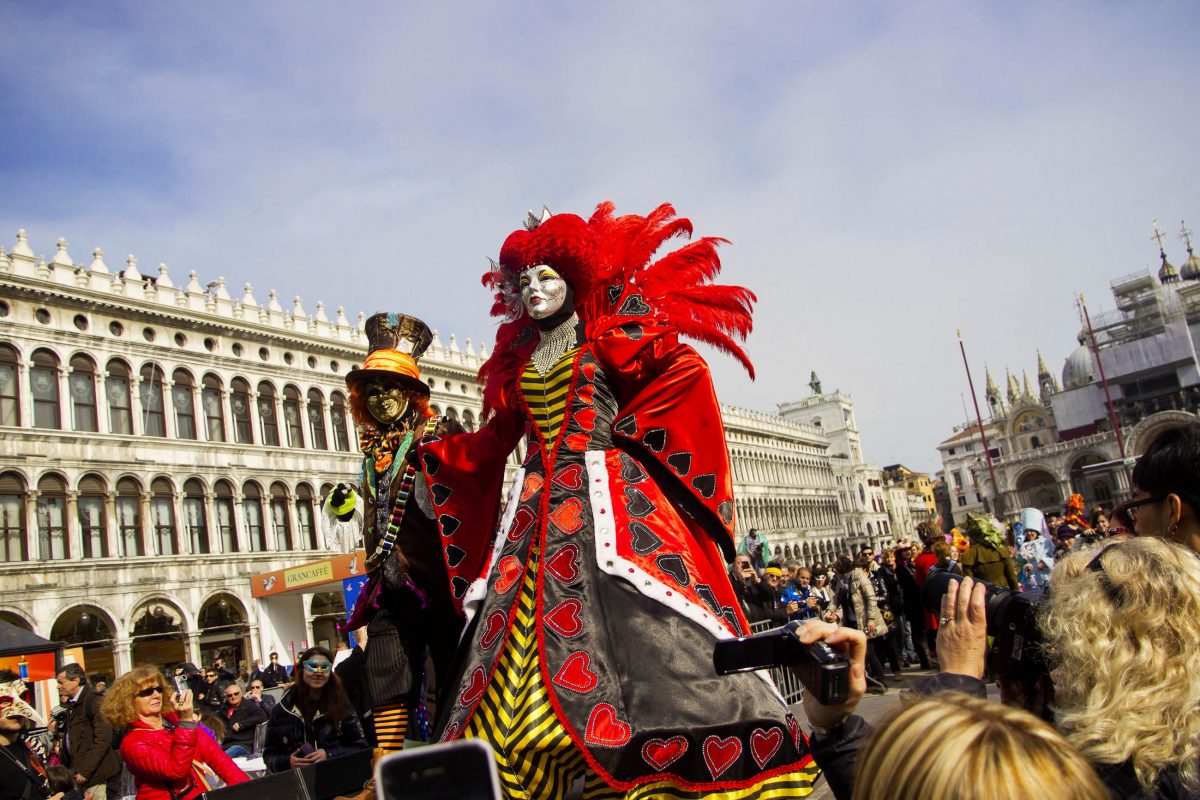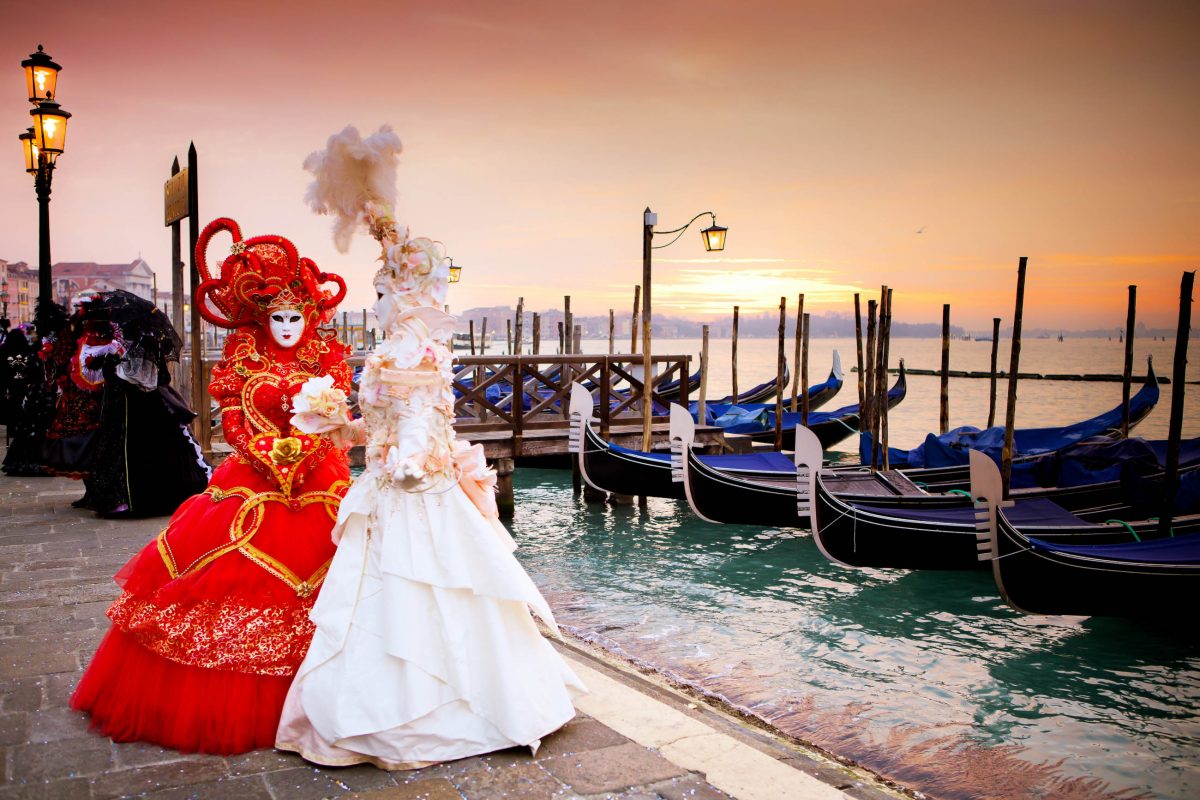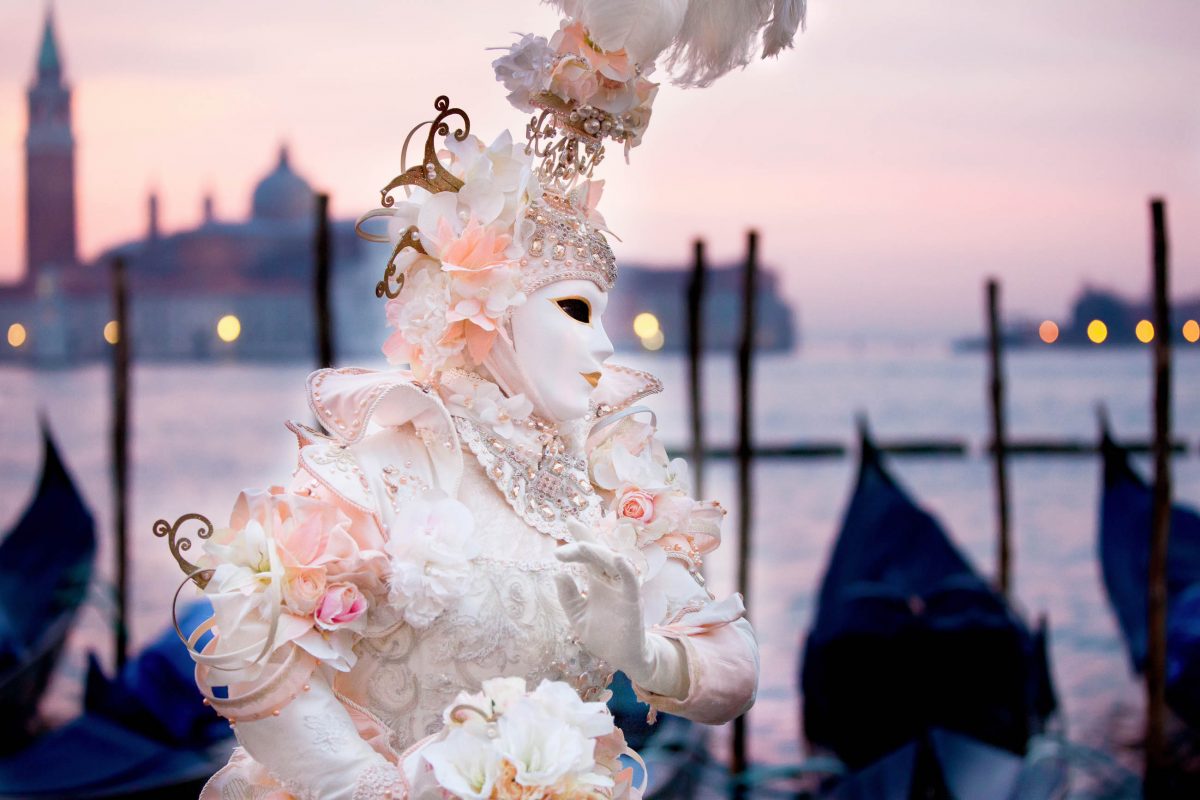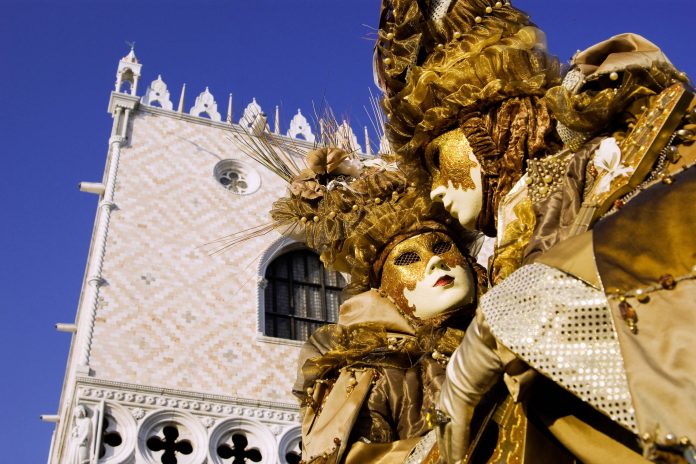Der Karneval in Venedig kann bis ins Mittelalter zurück verfolgt werden und zählt vor der imposanten Kulisse des Markusplatzes mit seinen weltbekannte Masken heute noch zu den schönsten und prunkvollsten Faschingsfesten der Welt.
Auf zu den Masken in Venedig! Die meisten Touristen treffen am Wochenende vor dem Aschermittwoch in der Stadt ein, doch auch bereits in den Tagen zuvor werden zahlreiche Theatervorstellungen aufgeführt und Privatpersonen flanieren in spektakulären Kostümen durch die Straßen Venedigs. Dabei konzentriert sich das Spektakel auf den Markusplatz und seine Umgebung, im Rest der Stadt sind nur vereinzelt maskierte Gestalten anzutreffen. Der Karneval von Venedig dauert zehn Tage.
Inhaltsverzeichnis
BILDER: Karneval in Venedig
Fotogalerie: Karneval in Venedig
Eröffnung des Karnevals von Venedig

Der Karneval von Venedig dauert zehn Tage und beginnt eine Woche vor Karnevalssonntag. Pünktlich um 12 Uhr wird das berühmte Volksfest auf dem Markusplatz mit dem spektakulären „Volo dell’angelo“ („Engelsflug“) eröffnet. Dabei schwebt jedes Jahr eine am Stahlseil gesicherte junge Schönheit von Venedigs berühmtestem Glockenturm, dem 99 Meter hohen Campanile. Tausende Maskierte und Unmaskierte begrüßen in einer Wolke aus Konfetti das rauschende Fest, das von Gästen aus aller Welt besucht wird.
Am Karnevalssonntag findet eine spektakuläre Parade statt, bei der die Teilnehmer ihre prachtvollen Kostüme zur Schau stellen. Die schönste und aufwändigste Maske wird jedes Jahr prämiert. An den anderen Wochentagen sind die ersten Kostümierten meist ab Mittag anzutreffen.
Sobald eine neue Maske auftaucht, ist sie meist sofort von Fotografen umringt, die alle die beste Perspektive erhaschen wollen. Um selbst einen Blick auf die Masken zu werfen, ist oft Ellbogen-Einsatz gefragt.
Tipp: Am Sonntag sind zwar die meisten und schönsten Masken zu sehen, dafür herrscht dann auch der größte Trubel. In den engen Gassen zwischen Markusplatz und Rialto-Brücke schieben sich die Menschenmassen und der Verkehr im Einbahnsystem durch Venedig – nichts für ungeduldige Gemüter!
Die Maske in Venedig

Die klassische Maske, die am Karneval von Venedig heute noch getragen wird, wird „Bauta“ genannt. Diese wurde schon von Johann Wolfgang von Goethe erwähnt und traditionellerweise in Schwarz oder Weiß gemeinsam mit einem schwarzen Umhang aus Samt oder Seide und einem Dreispitz getragen. Früher maskierte man sich in Venedig nicht nur zum Karneval, sondern auch für Bankette oder wichtige Festivitäten.
Auch Glücksspieler, die sich vor ihren Gläubigern verstecken wollten, gingen oft nur noch maskiert außer Haus. Mit der Zeit wurden die Masken immer kunstvoller und in der Malergilde entwickelte sich ein eigener Zweig der Maskenmacher. Die noch heute berühmten und bekannten venezianischen Masken wurden bald nach ganz Europa verschifft und erfreuen sich auch heute noch großer Beliebtheit.
Geschichte des Karnevals in Venedig

Der Karneval von Venedig kann zu Recht als historisch bezeichnet werden, denn er geht bis auf das Spätmittelalter zurück, als an den Fürstenhöfen Italiens zwischen dem Dreikönigstag (6. Jänner) bis zum Aschermittwoch gefeiert wurde. In einer Dogen-Chronik aus dem Jahr 1094 wurde der Karneval das erste Mal erwähnt, im 13. Jahrhundert war das erste Mal von Masken die Rede.
Bis 1797 wurde am Donnerstag vor dem Aschermittwoch außerdem jedes Jahr der Sieg Venedigs über Aquileia gefeiert, der 1162 errungen worden war. Seit dieser Zeit wurden sowohl Festlichkeiten als auch Kostüme immer prunkvoller und erreichten zu Zeiten Casanovas im 18. Jahrhundert ihre Hochblüte.
Wildes Treiben zu Casanovas Zeiten

Das ausgelassene Treiben bestand aus Wahrsagern, Gauklern, wilden Tieren in Zwingern, Quacksalbern mit fragwürdigen Heilmitteln, Marionetten, Feuerwerken, Akrobaten, Seiltänzern, Stierkämpfen und menschlichen Pyramiden. Der berühmte Engelsflug, mit dem Karneval noch heute eröffnet wird, kann bis ins Jahr 1548 zurückverfolgt werden. Allerdings wurden vom Artisten damals nur Blumen vom Campanile geworfen, wonach er an einem Seil wieder zu Boden spazierte.
Die durch Napoleon und mit dem Anschluss an Österreich folgende Wirtschaftskrise beendete jedoch 1797 jedoch die Glanzzeiten des Karnevals von Venedig. Nach dem Anschluss an Italien 1866 gab es erste Bestrebungen, das historische Fest wieder aufleben zu lassen.
Zur Pracht, wie man sie heute kennt, fand der Karneval jedoch erst im Jahr 1976 zurück, ausgelöst durch den Erfolg von Federico Fellinis Film „Casanova“ bei der Biennale. Die Touristen kamen nach Venedig, um den Karneval zu erleben und allen voran ließen Hotelbesitzer die fast vergessenen Traditionen wieder aufleben – die Masken waren zurück in Venedig.
Weiterführende Links:





